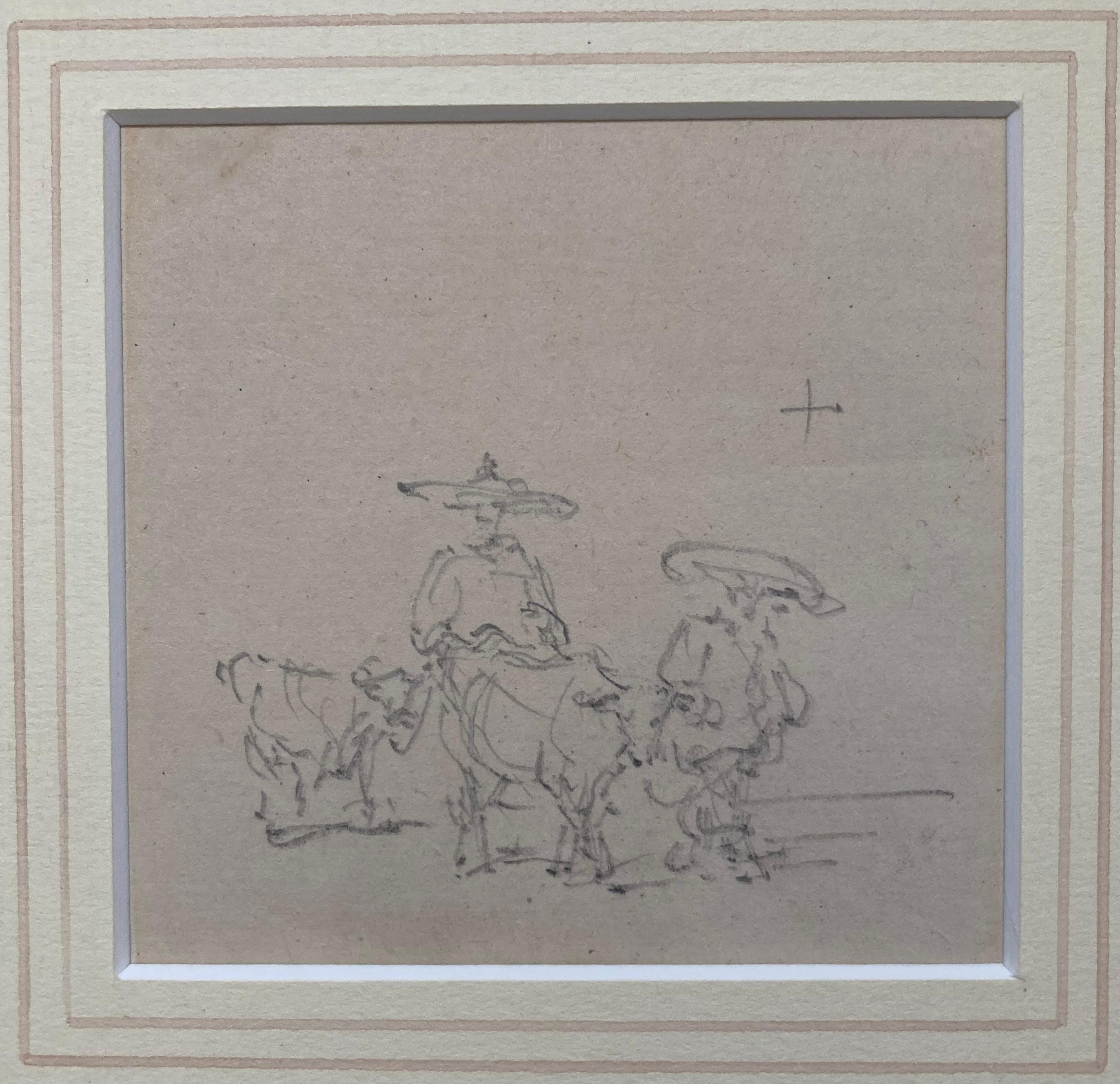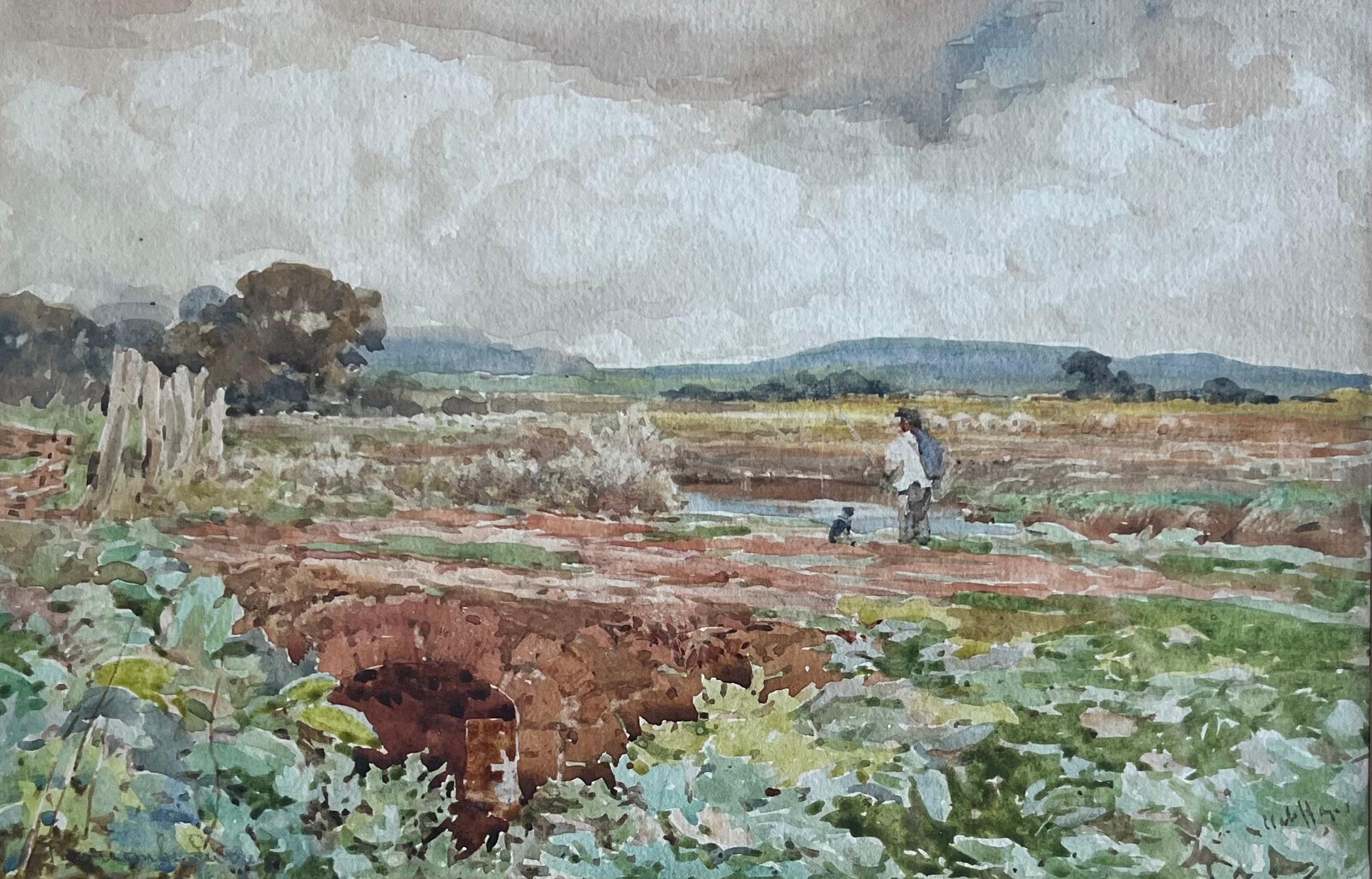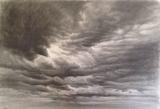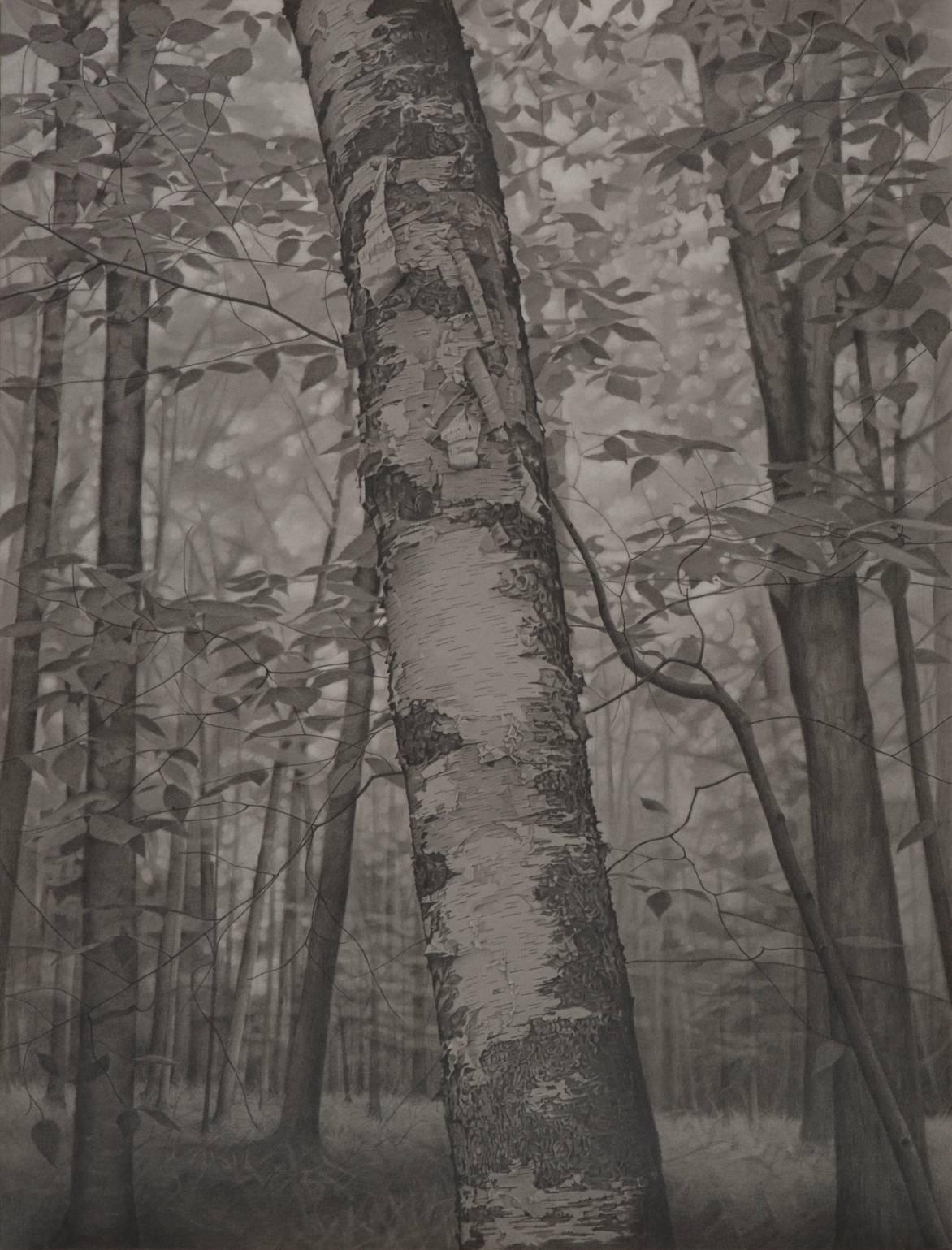Items Similar to Sketch-book Page, Shoreham, Samuel Palmer, Late 19th Century
Want more images or videos?
Request additional images or videos from the seller
1 of 4
Samuel Palmer (b.1805)Sketch-book Page, Shoreham, Samuel Palmer, Late 19th Century
About the Item
Graphite on paper, numerous pencil inscriptions
Image size: 5 1/2 x 21 1/2 inches (14 x 55 cm)
Period style hand made gilt frame
Provenance
The collection of Ernest Pearce (1930-2012) a dedicated art collector and connoisseur of the bookplate.
This drawing, taken from one of Samuel Palmer's sketch books, depicts Mepham Barn in Shoreham. In an articulated design of the landscape, the collection of farm buildings is framed by a wooded thicket and an expansive crop field, creating a cohesive composition. Covering the double page are multiple hand-written annotations given by the artist, noting the colours and hues of the reality of the scene depicted.
Between 1825 and 1832 Palmer executed brilliant studies of the landscape around Shoreham in Kent, a small village just south of London, while he lived there. The seven years formed the artist's most fertile period during which he was able to capture an intense response to a natural harmony born of moonlight and rural scenes. Although after he left almost half a century remained to him in which to paint, he never regained the spiritual vitality of these early years.
Palmer's work at Shoreham was made in isolation, intensely personal, part of a mystical and, often, overtly religious experience, shared only with a few other people. Whilst at Shoreham, Palmer looked long and hard at his surroundings, trying to penetrate the secrets of nature, the structures, and especially the associations with his imaginary landscapes. Palmer's earliest documented visit to Shoreham was in the summer of 1826 but it is often assumed that he visited the village as early at 1824 and had a connection to the location from such an early date.
This sketch of a selection of farm buildings alludes to one of Palmer's favourite motifs in his earlier works - the primitive cottage. The inclusion of this can be found in a number of his drawings in pen and ink from the end of the 1820s. Palmer wrote in his 1824 sketchbook, 'whatever you do, guard against bleakness & grandeur and try for the primitive cottage feeling'. For Palmer, the 'pastoral essence' that he strove to capture was dependant on the primitive cottage, the harmonious interaction of man with nature and the abundance of nature.
This is a rare opportunity to purchase such a work. In 1909, many of his Shoreham works were destroyed by his surviving son Alfred Herbert Palmer, who burnt "a great quantity of father's handiwork ... Knowing that no one would be able to make head or tail of what I burnt; I wished to save it from a more humiliating fate". The destruction included "sketchbooks, notebooks, and original works, and lasted for days".
The Artist
Samuel Palmer was a British landscape painter, etcher and printmaker. He also was a prolific writer and was a key figure in Romanticism in Britain and produced visionary pastoral paintings.
Palmer was born in London, the son of a bookseller and a nurse. Palmer painted churches from around age twelve, and first exhibited Turner-inspired works at the Royal Academy at the age of fourteen. Through John Linnell, he met William Blake in 1824. Blake's influence can be seen in work he produced over the next ten years (generally reckoned to be his greatest). The works were landscapes around Shoreham, near Sevenoaks in the west of Kent. They were among the few who saw the Shoreham paintings as, resulting from attacks by critics in 1825, he opened his early portfolios only to selected friends.
After returning to London in 1835, and using a small legacy to purchase a house in Marylebone, Palmer produced less mystical and more conventional work. Part of his reason in returning to London was to sell his work and earn money from private teaching. He had better health on his return to London, and was by then married to Hannah, daughter of the painter John Linnell who he had known since she was a child, and married when she was nineteen and he was thirty-two. Palmer turned more to watercolour which was gaining popularity in England.
From the early 1860s he gained some measure of critical success for his later landscapes, which had a touch of the early Shoreham work about them – most notable is the etching of The Lonely Tower (1879). He became a full member of the Water Colour Society in 1854, and its annual show gave him a yearly goal to work towards.Palmer's later years were darkened by the death in 1861, at the age of 19, of his elder son Thomas More Palmer – a devastating blow from which he never fully recovered. He lived in various places later in his life, including a small cottage and an unaffordable villa both in Kensington, where he lived at 6 Douro Place, then a cottage at Reigate. But it was only when a small measure of financial security came his way, that was he able to move to Furze Hill House in Redhill, Surrey, from 1862.
Palmer died in Redhill, Surrey, and is buried with his wife in St Mary's, Reigate churchyard.
- Creator:Samuel Palmer (b.1805) (1805 - 1881, British)
- Dimensions:Height: 5.5 in (13.97 cm)Width: 21.5 in (54.61 cm)
- More Editions & Sizes:1 of 1 Price: $14,941
- Medium:
- Movement & Style:
- Period:
- Condition:
- Gallery Location:London, GB
- Reference Number:1stDibs: LU52412682022
About the Seller
5.0
Gold Seller
These expertly vetted sellers are highly rated and consistently exceed customer expectations.
Established in 2007
1stDibs seller since 2014
64 sales on 1stDibs
Typical response time: 4 hours
- ShippingRetrieving quote...Ships From: London, United Kingdom
- Return PolicyA return for this item may be initiated within 14 days of delivery.
More From This SellerView All
- Ruins of Hailes Abbey, 19th century landscape sketchLocated in London, GBGraphite on buff paper 'Hales Abbey, Gloucestershire' initialled, inscribed and dated 1837 bottom left Image size: 8 x 13 1/2 inches (20 x 34.5 cm) 18th Century Hogarth frame and was...Category
1830s Victorian Landscape Drawings and Watercolors
MaterialsGraphite
- St Nicholas Cole Abbey and St Mary Somerset Church, London, The BlitzLocated in London, GBThis drawing records the destruction that was endured by London during the Blitz. The building in the foreground is St Nicholas Cole Abbey, situated in the city of London. Whilst a church was recorded on this site from the twelfth century, this church was destroyed in the Great Fire of London so the remnants of the church that we see here is one that was built by Sir Christopher Wren...Category
Mid-20th Century Modern Landscape Drawings and Watercolors
MaterialsPaper, Watercolor, Graphite
- Westminster Cathedral, 20th Century Graphite Sketch, English ArtistBy Gordon ScottLocated in London, GBGraphite on paper Image size: 11 x 8 ½ inches (28 x 22 cm) White gold frame Gordon Scott Gordon Scott was trained at the Royal College of Art (1934-38) under Gilbert Spencer, Alan ...Category
20th Century Modern Landscape Drawings and Watercolors
MaterialsPaper, Graphite
- Hornsley Rise, Graphite Sketch, 20th Century English ArtistBy Gordon ScottLocated in London, GBPencil and wash on paper Image size: 8 1/2 x 8 inches (22 x 20.25 cm) Contemporary style frame Gordon Scott Gordon Scott was trained at the Royal College of Art (1934-38) under Gil...Category
20th Century Modern Landscape Drawings and Watercolors
MaterialsPaper, Graphite
- The Cemetery, Graphite Sketch, 20th Century English Female ArtistLocated in London, GBGraphite on paper Image size: 7 x 5 inches (17.75 x 12.75 cm) Mounted Jane Ross Little is known about Jane Ross apart from that she attended Heatherley's Art School. Here she met ...Category
20th Century English School Landscape Drawings and Watercolors
MaterialsPaper, Graphite
- View of Cornwall, Graphite Sketch, 20th Century English Female ArtistLocated in London, GBGraphite on paper Image size: 5 1/4 x 8 inches (13 x 20.25 cm) Mounted Jane Ross Little is known about Jane Ross apart from that she attended Heatherley's Art School. Here she met...Category
20th Century English School Landscape Drawings and Watercolors
MaterialsPaper, Graphite
You May Also Like
- Early English topograpical watercolor of Chinese figuresLocated in Harkstead, GBA beautifully drawn pencil study of Chinese figures by one of the great topographical masters of the early 19th Century. George Chinnery (1774-1852) Chinese figures leading livestoc...Category
Early 19th Century Victorian Landscape Drawings and Watercolors
MaterialsPaper, Pencil
- English watercolour of a fisherman and his dogLocated in Harkstead, GBA very attractive rural scene of a fisherman and his dog on a riverbank, in very good colour and an appealing composition. Claude Hayes (1852-1922) A fisherman and his dog by a riverbank Signed Watercolour with touches of pencil 6½ x 10 inches, image only 13 x 16 inches with the frame Claude Hayes was a Dublin born painter who to avoid his father's wish to make a businessman of him ran away to sea and served on the Golden Fleece, one of the transports used in the Abyssinian expedition of 1867-68, and also spent a year in the United States. Returning to London, he studied art at Heatherley's and the Royal Academy Schools, and then in Antwerp, under Charles Verlat. He worked in Hampshire with James Aumonier and also in Surrey with William Charles Estall, whose sister he married. Hayes exhibited widely in London and provincial centres, and was elected a member of the Royal Institute of Painters in Water Colours in 1886, the Royal Institute of Oil Painters in 1883, and the Royal Scottish Society of Painters in Watercolour, 1902. He also showed at the RA, RBSA, Brook Street Art Gallery, Dudley Gallery, FAS, GI, Grosvenor Gallery, Walker Art Gallery, Liverpool, MAFA, RBA, RHA, Ridley Art Club, RSW and Walker's Gallery, London. In 1912, Claude Hayes represented England at the Venice Biennale. His work is in various public collections in England and Ireland including the Ulster Museum, Museums Sheffield, Torre Abbey Museum and the Leeds City Art Gallery. His father was the artist Edwin Hayes.Category
Late 19th Century Victorian Landscape Drawings and Watercolors
MaterialsWatercolor, Pencil, Paper
- Black Sky (The Cave Series), 3By Panos FamilisLocated in New York, NYBlack Sky (The Cave Series), 3 graphite on paper 77 x 112 cmCategory
21st Century and Contemporary Contemporary Abstract Drawings and Waterco...
MaterialsArchival Paper, Graphite
- Within the Forest, gray photorealist graphite landscape drawing, 2018By Mary ReillyLocated in New York, NYIn her newest landscape drawing, Within the Forest, Mary Reilly explores the full tonal depth of graphite. She finds all of the soft subtleties of gray in her movement from the momen...Category
2010s Photorealist Landscape Drawings and Watercolors
MaterialsPaper, Graphite
- BLUE JAY WAYBy Christina McPheeLocated in New York, NYBLUE JAY WAY, 2012 ink and graphite on Arches cold press paper 44.5 x 75 inches / 1130 x 1905 mm unframed Christina McPhee’s expansive abstract paintings, drawings, photographs, and videos test or query how can we know, and who is we? Moving from within a matrix of measurement, observation and contingent effects, her work resists characterization as product, and continually accesses fields outside itself. For her, process equals trial. Her work emulates potential forms of life, in various systems and territories, from a perspective of the non-self– a world beyond identity. McPhee’s dynamic, performative, physical engagement with materials, in both her analogue and digital works, is a seduction into surface-skidding calligraphic gestures and mark-making. The tactics of living are in subterfuge, like the ‘dazzle ships...Category
21st Century and Contemporary Abstract Abstract Drawings and Watercolors
MaterialsArchival Ink, Archival Paper, Graphite
- Ice 1, photorealist graphite nature drawing, 2018By Mary ReillyLocated in New York, NYReilly uses a toning technique to endow her graphite works with a smooth, seamless quality. Rather than distinct outlines, her seashells glide gracefully into one another, creating a...Category
2010s Photorealist Landscape Drawings and Watercolors
MaterialsPaper, Graphite




